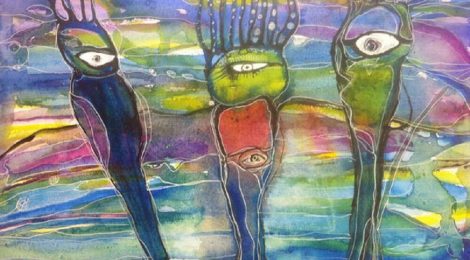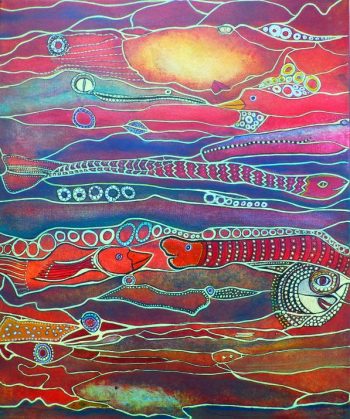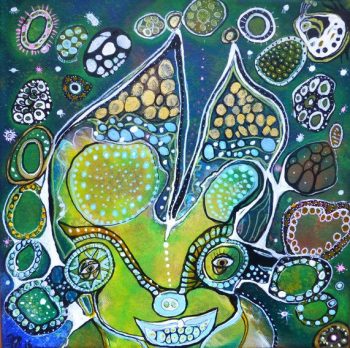
Surprising Side Effect of Parkinson’s Drug: Compulsive Creativity
In 2014, Ingrid Hauff was diagnosed with Parkinson’s disease (PD), a degenerative disorder that attacks the nervous system, leading to speech impairment, loss of control over body movement, and a long list of other symptoms. Plus, there is no cure.
Struggling with the diagnosis, Hauff checked herself into a psychiatric clinic where she was introduced to art therapy. The clinic supplied her with materials, and the staff asked her to paint what she felt. She initially used painting as a way to cope with the illness.
Hauff tells the Trauma and Mental Health Report:
“Before my diagnosis, I never painted. I could never have imagined that painting would be so important to me like it is today. I paint every day. It is a great pleasure for me to paint. I forget every trouble, and I find the [disease’s] side effects are lessened.”
Painting has become more than therapy for Hauff. It’s now a fundamental part of her life, and her unique artistic style and choice of colour have helped her become a successful artist. She has even held an exhibition of her landscape paintings in Berlin.

But her story of artistic knack and creative development is, surprisingly, not a rare one for those diagnosed with PD. Some scientists are investigating whether medications, such as Levodopa and Pramipexol, prescribed to relieve PD symptoms, heighten creativity. These drugs increase the neurotransmitter dopamine, a chemical in the brain that regulates movement. Dopamine is gradually depleted as PD progresses, so boosting this neurotransmitter allows patients to retain regular movement and regain control over their bodies.
Like all medications, though, these drugs have a multitude of side effects, ranging from headaches and nausea, to tremors and hallucinations. Unlike other medications, however, one side effect stands out from the rest: uninhibited creativity.
Neurologist Rivka Inzelberg and colleagues published a study in 2014, finding that patients treated with dopaminergic drugs showed enhanced verbal and visual creativity in comparison to neurologically healthy individuals who were not on the medication. This is one of several studies where Inzelberg demonstrated that PD medications are associated with higher rates of creative capability.
But in some instances, patients claim to produce artwork to a point where they can’t restrain themselves. Eugénie Lhommée and her colleagues interviewed people with PD and published a case study on the influence of increased dopamine on creativity. In it, the patient reported:
“I transformed my home into a studio, with tables and canvases everywhere [and] started painting from morning till night. I used knives, forks, sponges […] I would gouge open tubes of paint—it was everywhere. I started painting on the walls, the furniture, even the washing machine. I would paint any surface I came across. I could not stop myself from painting and repainting every night in a trance-like state. My partner could no longer bear it. People close to me realized that I crossed some kind of line into the pathological, and, at their instigation, I was hospitalized.”
Hauff also experienced an “extreme influence” on her artwork when prescribed Pramipexol:
“I began painting for hours every night. I didn’t have any ability to stop. I lost a lot of sleep and was constantly without energy after these sessions, so I decided, together with my neurologist, to stop [Pramipexol]. I’ve been off of it since the beginning of February 2017, and now after one month [on new medication], I can declare that my feeling of control has come back.”

While these experiences can be damaging to patients and their loved ones, Hauff was able to take advantage of this unique side effect by exhibiting and selling the artwork she had produced. Her solution to the problem was to switch to a different medication. The creative boost remained, but the compelling drive disappeared. Hauff explains:
“My creativity is still there, but the ‘painting time’ is now reduced radically. I am painting only during the daytime. My opinion is that Pramipexol limits my ability to maintain self-control.”
But Hauff has no regrets about her experience with Pramipexol:
“It let me find my creativity and showed me what I can do. It showed me secret parts of my soul. It showed me what has slept in my brain and in my heart for nearly 60 years. It showed me a way to live with my Parkinson’s.”
As is the case for most individuals considering a drug therapy, people with PD have to weigh the benefits and drawbacks of medication options. But as more research on this unexpected and artistic by-product emerges, it begs the question of whether similar medications can be used to boost creativity in the future.
– Ty LeBlanc, Contributing Writer.
Image Credits
Feature: Ingrid Hauff, Used With Permission
First: Ingrid Hauff, Used With Permission
Second: Ingrid Hauff, Used With Permission




“Uninhibited creativity” as a drug side-effect! … “It showed me secret parts of my soul.”
Fascinating story!